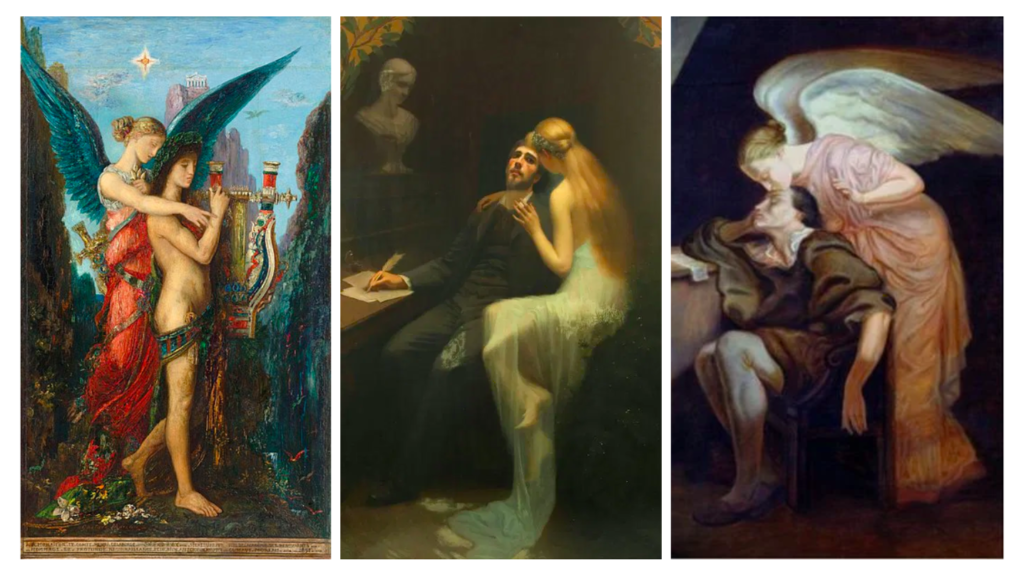Blank page syndrome, writer’s block—call it whatever you want, most creators have once faced this overwhelming lack of inspiration. If you do experience writer’s block from time to time, the best reaction is to go do something else: going for a walk, journaling, talking it out with a friend. Better yet, though, is to avoid writer’s block together by not relying on flimsy, unpredictable inspiration. Instead, use idea sex to programme your creativity.
Waiting for your muse
How do creators find ideas to write about? Poets, artists, and authors alike have been wondering about the source of our inspiration for millennia. In ancient Greek mythology, the Muses are the nine sister goddesses presiding over literature and the arts. These goddesses were considered the source of the inspiration embodied in the songs and poetry related first orally, then in written form, across the centuries.
Since then, the word “muse” has been used to describe a mythical entity which inspires musicians, artists, and writers.

Many poets despaired when their muse did not visit them, and some artists even relied on external help to force their inspiration. For instance, the link between opium and Romanticism is so strong it has its own Wikipedia page. M. H. Abrams, a literary critic known for his work on Romanticism, explains how a poet from this era “utilised the imagery from these dreams in his literary creations, and sometimes, under the direct inspiration of opium, achieved his best writing.”
While we have fortunately moved away from using such dangerous drugs to force our inspiration, the idea that creativity is something uncontrollable you either experience or not—that a sort of elusive muse may visit us to whisper ideas in our ear—is still prevalent among creators. But inspiration can, in fact, be programmed so you can generate ideas on demand.
“I am my own muse. I am the subject I know best. The subject I want to know better.”
Frida Kahlo
Idea sex for active idea generation
Idea sex is the process through which ideas “mate” to produce new ideas. While the process itself is nothing new, it is unclear who first used the term. Science writer Matt Ridley gave a TED talk about the concept of idea sex in 2010. The term “idea sex” was then made popular by entrepreneur James Altucher. Since then, it’s been used extensively by many authors to describe combinational creativity. So what’s the difference between inspiration and idea sex?
Inspiration is passive: you wait for it to happen to you. It’s unpredictable: you can’t just experience it on demand. And finally, using inspiration as your main source of new ideas is stressful: if you need to write something and you don’t feel inspired, there is not much you can do about it except take a break and go for a walk.
Idea sex, on the other hand, is active: you can proactively decide to combine two or more ideas and to see what interesting new idea may come out of the experiment. It’s programmable: if you create a sustainable system for yourself to combine ideas together, you will be able to create new ideas on demand. And it’s mindful: instead of forcing yourself to stare at a blank page until your muse pays you a visit, it’s about looking through your network of ideas to find a trail to explore.
| Inspiration | Idea Sex |
| Passive Unpredictable Stressful | Active Programmable Mindful |
Idea sex for sustainable creativity
In order for two ideas to have sex, they need to stay in the same room for long enough. This is why taking smart notes is core to idea sex. Instead of waiting for inspiration until you sit down in front of your computer to write a piece of content, incorporate idea sex into your creative process.
- Be selective when saving ideas. Before adding something to your note-taking app, ask yourself: does this idea connect to any other idea that’s already in the system? If yes, make sure to connect the two ideas together through an internal link. If no immediate link comes to mind, spend a couple of minutes trying to find a connection. If really nothing comes to mind, it may not be useful to make a note of that idea, as there will be no trail of thought which will bring you back to it in the future.
- Proactively connect ideas together. Block time for mind gardening. Go back to some recent ideas you saved in your note-taking system and try to find new connections. Use networked thinking such as mind maps and concept maps to think your way through these potential connections, and progressively build a mental atlas.
- Let your ideas evolve. Ideas are not set in stone. If connecting two ideas together makes you realise an idea you wrote about in the past feels outdated, create a new version. Some people like to “fork” the idea to keep a trail of their thoughts, others just edit their old ideas to update them. There is no right or wrong way to go about it—especially as many note-taking tools offer versioning—but make sure you don’t consider anything you have written down as too sacred to edit.
You can also practice idea sex with other people. Share your ideas with the world, learn from others, and proactively connect ideas together during conversations. If you keep on following these steps while reading content and taking notes, new ideas will naturally emerge from the combination of other people’s ideas. Instead of experiencing writer’s block or a lack of inspiration, you may experience another challenge: having too many ideas to select from.
